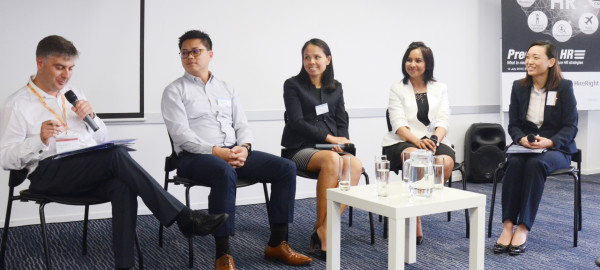
Moderator: Paul Arkwright, Publisher & Editor-in-Chief, HR Magazine; The Panel from left to right: Alex Yeung, Director—Human Resources Shared Services, Asia Pacific, Avery Dennison; Kerry Rooks, Chief Human Resources Officer, Prudential Hong Kong Limited; Debbie Mannas, Group Head of Human Resources, Wallem Group; Ella Ip, Strategic Business Planning, Greater China Transformation, Maybank
Moderated by HR Magazine’s Paul Arkwright, a key question was posed, “What are the most important metrics to measure?” Ip offered her opinion, “Productivity, sustainability, cost to income ration, total personnel cost and total profits before tax.” The rest of the panel also agreed with these and the unanimous consensus was that turnover was of the highest priority.
Rooks noted, “We have to measure quite a lot—first year turnover, turnover overall and engagement. To measure the latter we do engagement surveys.” She remarked that sometimes staff in all organisations may not be so open. In high turnover departments, surveys returned by employees may indicate that they are happy—whereas the data may contradict this. This is not because people are dishonest but rather they are not confident in anonymity of the survey.
Metrics will bring to light discrepancies between employee feedback and the actual workplace status. Staff will not discuss issues in a survey, so they report different things to how they are actually feeling. Mannas observed, “Metrics allows us to gauge a realistic view of what people think of management, as you just don’t know how much you can trust from surveys.”
Once the data is collected it needs to be sorted into relevant categories—turnover, ROI etc.—it can then be brought to line managers for analysis. Rooks warned that some resistance is to be expected as they are busy and do not like to be criticised. Some conversations may be uncomfortable regarding performance reports—the good and the bad. She continued, “When you bring this data to the table to discuss with line managers they might hate it. But it isn’t being confrontational—it’s being honest. There is no room for emotion when it comes to metrics, only mature professional discussion.”
Leveraging these results takes trial and error. Allowing time to run possible solutions on small batches of employees before rolling out over the entire workforce can help avoid costly mistakes which do not give a worthwhile return. Yeung pointed out that sometimes initial errors in calculations can lead to problems down the line. As an example, sometimes different departments may be analysing different time periods. He added, “Look at the data and discuss where the discrepancies arise. Are the same cut-off dates for calculations being used by HR and the finance department, as an example.”
Key insights in leveraging metrics:
- Data needs to be collected and utilised
- Metrics require perseverance and time to work to produce the best results
- Metrics show hard facts—people are emotional; metrics removes that from the equation.




